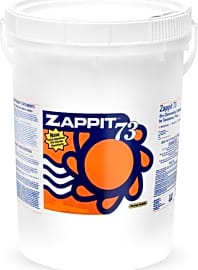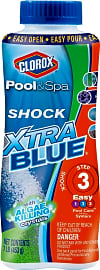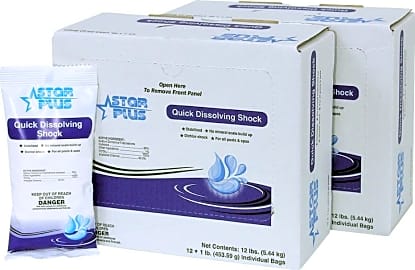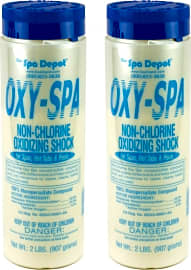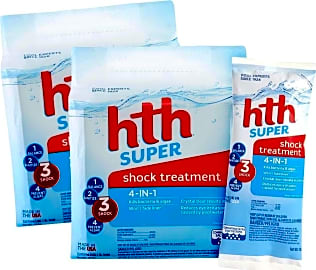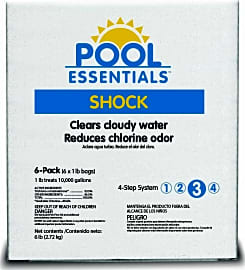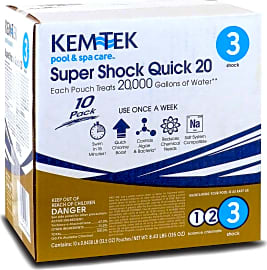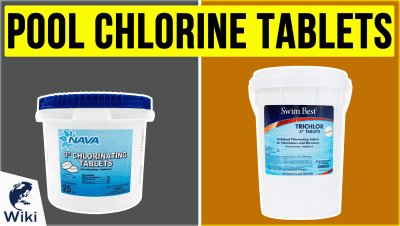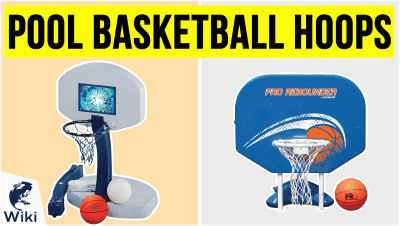The 10 Best Pool Shocks

This wiki has been updated 43 times since it was first published in August of 2015. Pool shocks can be a quick and effective treatment when you have particularly mucky water. They'll eliminate algae and bacteria, often while maintaining your water's pH balance. Keep your backyard oasis sparkling with something from our selection, which includes fast-acting options that are simple to administer. They also work well for deploying at the beginning and end of the swimming season. When users buy our independently chosen editorial choices, we may earn commissions to help fund the Wiki.
Editor's Notes
April 22, 2019:
Anyone who's ever owned a pool knows that they need consistent care and maintenance to stay sparkling clean. We considered the top contenders in the category and prioritized ease of use, effectiveness, price, how well they dissolve and how quickly you'll be able to jump back into the water when all is said and done. Oxy-Spa MPS and Clorox 33012CLX each come in easy-pour bottles with resealable lids, while Zappit Cal Hypo arrives in a resealable bucket complete with a measuring cup, making these options ideal for those who'd like to keep things as tidy and simple as possible. Doheny's Super Bag are pre-measured and boast a two to three-year shelf life, which is nearly double many competitors. This makes them suitable for users who don't have heated pools and usually pause treatments for the duration of winter. Each selection uses a different formula to eliminate murkiness and remove residual foreign matter, such as lotion, cosmetics, natural oils, sweat, and deodorants, all while not staining, fading, or otherwise damaging your pool and its materials.
What Is Pool Shock And Why Is It Needed
It can be in the form of sunscreen, dead skin cells, and sweat.
Pool shock is a concentrated chemical that can either be chlorine or non-chlorine based. It is used to increase free chlorine levels in your pool thereby decreasing combined chlorine. Combined chlorine or inactive chlorine is responsible for the skin irritation, red-eye and chlorine smell that people experience in some swimming pools. It is formed when the available chlorine you add to your pool in the form of sanitizer combines with organic compounds after it breaks them down and kills them. Once it has combined with the dead organic matter, it becomes inactive and is known as chloramine. The only way to remove combined chlorine is by adding excess free chlorine, which breaks apart the chloramine molecules and oxidizes it.
Without proper swimming pool sanitation, pools would quickly become filled with harmful bacteria that could cause swimmers to become sick. In addition to regularly adding chlorine or another sanitizer, pools must be shocked periodically to keep them clean and safe for swimming. The more often a pool is used, the more often it must be shocked. This is because the majority of the organic matter that renders free chlorine inactive comes from bathers. It can be in the form of sunscreen, dead skin cells, and sweat. Additional organic matter comes from leaves and dirt that enters your pool from the environment.
Adding pool shock gives your regularly used sanitizer a boost when levels are running low. Shocking a pool is also a great way to help establish correct levels of free chlorine in a newly filled swimming pool or one that is being readied for the summer after winter time neglect.
Types Of Pool Shock
Pool shocks can be chlorine or non-chlorine-based. Chlorine-based pool shocks include calcium hypochlorite, commonly referred to as Cal-Hypo, Lithium Hypochlorite, and dichloroisocyanuric acid, more commonly referred to as Di-Chlor. Non-chlorine-based pool shock is made from potassium monopersulfate.
Instead of adding additional chlorine to a pool, potassium monopersulfate oxidizes the organic matter so the current chlorine in your pool can do its job more effectively.
Cal-Hypo is the most commonly used pool shock in home pools and is also the most powerful in terms of oxidation. Its main ingredient is calcium hypochlorite, and it is available in different concentrations, usually in the 65% to 75% range. There are also Cal-Hypo pool shocks advertised as allowing you to begin swimming within 15 minutes after use. This is because these products typically contain just 47% calcium hypchlorite, which may be enough to allow swimming without irritation, but is often not enough to effectively destroy all bacteria and chloramine molecules. Cal-Hypo will add both calcium and chlorine to your pool, so if your calcium hardiness is already high, it might be best to consider another shock option.
Lithium hypochlorite pool shocks are one of the best options, but are often overlooked by pool owners because of their higher cost. It is a completely soluble fine granular that dissolves instantly in water. Instead of incorporating a calcium filler like Hypo-Cal, it utilizes lithium. The standard formula contains 29% lithium hypochlorite and 35% free chlorine. It can be used in all pool types, including those with vinyl liners, leaves no binder residues, and allows you to begin swimming immediately after use.
Di-Chlor also dissolves rapidly and can safely be used in vinyl-lined pools. It is less costly than lithium hypochlorite, but more costly than Hypo-Cal. Instead of calcium or lithium, it makes use of cyanuric acid. The use of cynauric acid is a double-edged sword. On one hand, it prevents chlorine from quickly dissipating in direct sunlight, but over time excessive use can cause a buildup which limits chlorine's effectiveness.
Potassium monopersulfate non-chlorine pool shocks are not as powerful as chlorine-based products, but they are a good alternative to those worried about the harmful effects of excessive chlorine use. Instead of adding additional chlorine to a pool, potassium monopersulfate oxidizes the organic matter so the current chlorine in your pool can do its job more effectively. They also help remove cloudiness from a pool's water. Potassium monopersulfate pool shocks are pH neutral, calcium-free, and allow you to swim immediately after use.
How To Shock A Pool
When shocking a pool, it is important that you take the necessary safety precautions to avoid injuring yourself or damaging your pool. Wear safety gloves to protect your hands and glasses to protect your eyes.
If you add the pool shock to the bucket first, you run the risk of it splashing onto you as you fill the bucket with water.
The first step is to fill a five gallon bucket with water. Always add pool shock to water, never the other way around. If you add the pool shock to the bucket first, you run the risk of it splashing onto you as you fill the bucket with water. Stir the pool shock around the bucket and agitate the water to dissolve the shock granules. Once it is completely dissolved, you can begin adding the mixture to your pool water.
With the filter running, slowly pour the shock and water mixture into your pool water directly in front of the pump's return line fitting. This will help to circulate the shock around the pool and ensure that it doesn't settle onto the bottom. Never pour it directly into the skimmer.
When you have about 25% of the shock and water mixture left in the bucket, stop pouring it into the pool and add more water to top of the bucket. This will help dissolve any shock granules which did not fully dissolve the first time. If you see any granules settling on your pool floor, take out your pool brush and sweep them around to help them dissolve. If left on the pool floor they can damage it and cause bleaching.



